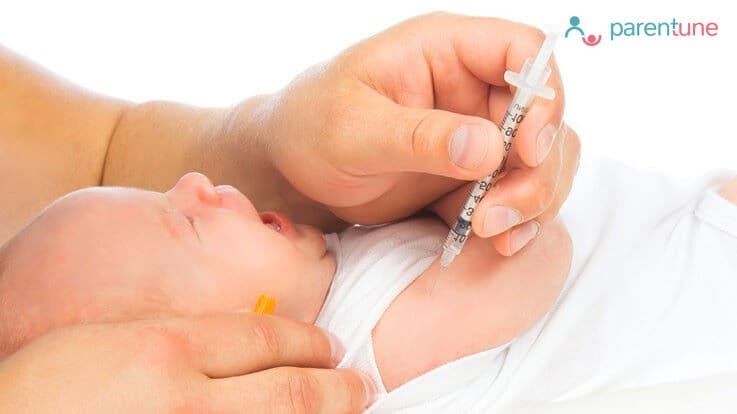aggression
How to Reduce Vaccination Pain or Swelling in Babies

Published: 13/11/19
Updated: 22/12/21
Nowadays there are several debates going on regarding vaccination. There are people advocating for and against vaccination. However, vaccination is considered as a social responsibility by most of the people. All the same, approaching the baby vaccination date gives most of the mothers sleepless nights. This is because most of the immunizations / vaccinations are given as shots. No mother likes to watch their baby in pain after the shots.
Do you know a fact that before their second birthday, babies get around 20 shots in the name of vaccinations? Some vaccines cause more uneasiness than others. Vaccination pain in infants can make the baby unmanageable. But here are few tips to soothe baby from the post-vaccination shot and give vaccination pain relief for babies. Continue reading to know the ways to ease your baby's vaccination pain and how to reduce pain after vaccination, and get answers to the most common concerns like how to reduce swelling after vaccination, how to reduce pain after injection, hot compress after vaccination, home remedy for vaccine pain, how to reduce pain after vaccination, swelling after injection in babies, baby crying uncontrollably after vaccination, after vaccination baby care and many others.

Ways to Reduce Vaccination Injection Pain or Swelling
Here are a few tips, hints, and a few tactics to relieve swelling or pain after vaccination shots in infants.
Doctor Q&As from Parents like you
-
Breastfeed Questions: Breastfeeding is an excellent means of injection pain relief for babies. A recent study proves that babies who were breastfed during the vaccination cried less. Breastfeeding will ease your baby's tears and fears with its soothing effect. Hungry and pain after vaccination together with low-grade fever will make the baby crabbier. Breastfeeding is strongly recommended for vaccination pain in infants. It will help to hydrate the baby. Please note that after an oral vaccine never breastfeed for ½ an hour as there are increased chances for the baby to vomit out the vaccine.
-
Opt Either Painless Injection or Combination Shots: Nowadays, two types of immunization shots are available. 'Painful' and a 'Painless'. It is basically a whole-cell and acellular vaccine respectively. When the baby is given the whole-cell vaccine, he or she develops a fever, pain, and redness around the spot of injection, while in acellular form, which contains fewer antigens pose no such side effects. As a result, they lower the pain that your infant might experience otherwise. It is costlier than the whole-cell vaccine. Some of the vaccines also come as combination shots. Vaccinations for several diseases can be combined into a single shot. This way, you can reduce the number of injections your baby requires, which in turn reduces vaccination pain
-
Restrict the Movement: The majority of the vaccination shots are usually given in the thigh (apart from the BCG shot that is given in the arm). Therefore the upper thigh area will swell with pain, making the movement more painful. For that reason, never let the older children walk or move the leg fast and likewise, hold the infants in a correct position. This will ease the pain of vaccination to some extent. To restrict their movement, obviously, stay very close to them. On the other hand, you should be concerned about mobility if you notice the kid is not able to move around like before even after two days of the vaccination
-
Distract the Infant: One of the best ways to help your baby calm down after being vaccinated is to distract him. here are some simple tricks to distract the baby from the vaccination pain. You can pick that suits you and your baby's age: Hold your baby on your lap and sing to him, tell him stories or talk to him in the soothing sound Read out his favourite storybook Give him a new toy. Anything new will grab the baby's attention for a while, playing a game of peek-a-boo could also help. Try switching the TV on
-
Apply the Ice Pack on the Injection Site: Some home remedies like these can provide relief to your child. To ease the pain, apply ice-packs gently on the site of the shot. This will help to soothe the inflammation. For this, take an ice-cube and rub it over your palms. Now gently pat on the injection site. (Never rub the ice cube directly on the baby's skin. This will make worse already inflamed skin creating more pain). Once the baby feels a little comfortable with the cold sensation, you can drape an ice-cube in a clean cloth and press it gently over the area. Do this at least twice or thrice during the day
-
Sugar Water: Several studies have found that sugar can ease vaccination pain. Try giving your baby a little sugar water before the vaccination. You can even dip a pacifier into the sweet liquid and let the baby suck on it during the injection. This formula can be administered to babies who cannot be breastfed during the vaccination. This sweet trick is mainly helpful for babies under six months of age
-
Give Paracetamol Drops: You can ease the infant's post-vaccination pain by giving paracetamol drops. Most often the doctor would prescribe paracetamol drops to ease the pains. Never give it to the child without asking your child's doctor. Also, never exceed the amount of dose prescribed by your doctor
-
Numbing Medicine May Soothe a Newborn: Rub-on medications that numb the skin can be used to ease the vaccination pain. However, the rub on local anesthetic cream can take about an hour to start working. Numbing sprays that numb the skin by cooling it can be more helpful as it works in a few seconds. You should ask your doctor before opting for this.
-
Rub your baby's skin after the vaccination after the vaccination, gently rub your baby's skin near the injection site. Just 10 seconds of rubbing can significantly bring down the intensity of the pain.
-
Give More Attention: At least for a day or two after the vaccination, irrespective of the intensity of the pain and inflammation, your baby needs more warmth and comfort from you. Keep yourself calm and always stay close to the baby. For babies under six months of age, skin-to-skin contact will provide more comfort.
What are the side effects of vaccination in infants?
After immunization shots, chances are that infants can develop the following issues or side effects. Some of the side-effects of vaccination in infants include:
Fever:
After a shot, the child usually develops a slight fever.
Swelling or Redness:
Redness and swelling after vaccination are quite common. The child most often develops redness, tenderness or swelling around the site of the shot.
Restlessness & Poor Appetite:
For a few hours after getting immunized, the infant can show restlessness and drowsy and may decline food.
Can Develop a Mild Skin-rash:
It is quite normal for the child to develop a skin rash 7 to 14 days after the chickenpox or measles, mumps, and rubella (MMR) shot. These types of rashes go away, devoid of any treatment. [ Read More - New Born Baby Vaccines Side Effects, Precautions & Soothing ]
Post-vaccination baby care is important and can help a great deal in reducing pain and swelling. These are some ways on how to get relief from vaccination pain.
Did you like the blog? Did you find it useful? Please share your thoughts with us in the comments section below; we'd love to hear from you.
Be the first to support
Be the first to share
Related Blogs & Vlogs
No related events found.